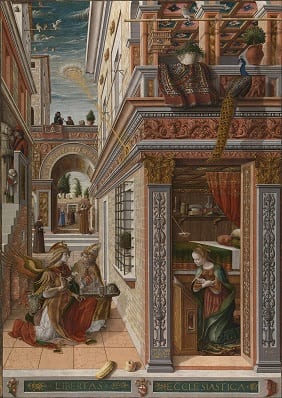
30 April – 21 September 2014
This spring, the National Gallery presents the first exhibition in Britain to explore the role of architecture within painting, and focusses on Italian Renaissance painting of the 14th, 15th and 16th centuries.
Building the Picture: Architecture in Italian Renaissance Painting aims to increase visitors’ appreciation and understanding of some of the most beautiful and architectonic paintings by Italian masters such as Duccio, Botticelli, Crivelli and their contemporaries. Visitors will be encouraged to look in new ways at buildings depicted in paintings, and to investigate how artists invented spaces in mind and paint that transcended the reality of bricks, mortar and marble.
With a record-breaking six million visits during 2013, the National Gallery remains committed to researching and showcasing its extraordinarily rich permanent collection. As a result of the research partnership between the National Gallery and the University of York, this exhibition offers a fresh interpretation of some of the National Gallery’s own Italian Renaissance collections. In addition, Building the Picture will include the Venetian master Sebastiano del Piombo’s The Judgement of Solomon (Kingston Lacy, The Bankes Collection, National Trust), on display in London for the first time in 30 years, and ‘The Ruskin Madonna’ by Andrea del Verrocchio (National Gallery of Scotland).
In Renaissance Italy, art and architecture were closely interconnected and the boundaries between all the arts were fluid. An important reason for this was that there was no specific educational programme or apprenticeship for architects. The Florentine architect Brunelleschi, for example, trained as a goldsmith, while Michelangelo was a painter and sculptor before he designed buildings. Five short films commissioned to coincide with this exhibition demonstrate how contemporary practitioners and thinkers are again blurring the boundaries between media and forms of practice. The films provide modern perspectives on real and imagined architecture from award-winning Swiss architect Peter Zumthor, film-maker Martha Fiennes, art historian T. J. Clark, film historian John David Rhodes and computer game cinematic director Peter Gornstein.
Caroline Campbell, Curator of Italian Paintings before 1500, said: “This exhibition provides a wonderful opportunity to think about how pictures can achieve an architectural sort of beauty. We can look beyond perspective to appreciate the imagined and fantastical spaces created by architecture. And the sense of mass, scale and three-dimensionality introduced by buildings changes the balance and feel of a painting.”
Building the Picture explores the roles played by architecture in painting and how it affects the viewing process. Architecture within paintings has often been treated as a passive background or as subordinate to the figures. This exhibition shows how, on the contrary, architecture underpinned many paintings, and was used to design the whole picture from the very start. This was the case in Sandro Botticelli’s Adoration of the Kings, where the ruins in the picture were planned first and still dominate the composition. Renaissance paintings are full of arches, doorways and thresholds, like those in Carlo Crivelli’sThe Annunciation, with Saint Emidius that invite the viewer into the picture and encourage us to begin a visual journey. Architecture could also be designed to tell a story, articulating the plot, deepening our understanding of the narrative and helping us to engage with the events. In Domenico Veneziano’s Saint Zenobius Bishop of Florence restores to lise a widow’s son killed by an ox cart in Borgo degli Albizzi, Florence from the Fitzwilliam Museum in Cambridge, the compressed perspective of the street heightens the emotion of the desperate mother whose son had just died.
Building the Picture: Architecture in Italian Renaissance Painting is an online catalogue produced by the National Gallery to accompany the exhibition. Nicholas Penny, Director of the National Gallery, says: “I am delighted that this catalogue will be permanently accessible on the National Gallery website, where it can be read and enjoyed by a very wide audience.”
Building the Picture: Architecture in Italian Renaissance Painting is curated by Dr. Amanda Lillie, Reader in History of Art at the University of York; and Caroline Campbell, Curator of Italian Paintings before 1500; with Alasdair Flint, CDA PHD student, University of York/National Gallery.
For further information, please contact Alexandra Moskalenko at alexandra.moskalenko@ng-
Publicity images can be obtained from http://press.ng-london.org.uk. To obtain a username please contact the National Gallery Press Office on 020 7747 2865 or email press@ng-london.org.uk
For public enquiries, please contact 020 7747 2885 or information@ng-london.org.uk
NOTES TO EDITORS
This exhibition forms part of Renaissance Spring, a season of exhibitions and events celebrating the Renaissance at the National Gallery.
Strange Beauty: Masters of the German Renaissance (19 February – 11 May 2014)
Veronese: Magnificence in Renaissance Venice (19 March – 15 June 2014)
Organisation
Building the Picture: Architecture in Italian Renaissance Painting is organised by the National Gallery, London.
This exhibition is part of the research partnership between the National Gallery and the History of Art Department at the University of York. The Arts and Humanities Research Council (AHRC) have funded the research and development of the exhibition, including the production of the online exhibition catalogue, and a number of short filmed interviews with contemporary cultural figures, addressing the interaction of painting and architecture.
Publication
Building the Picture: Architecture in Italian Renaissance Painting is an online exhibition catalogue produced by the National Gallery to accompany the exhibition. This digital catalogue is accessible online at: www.nationalgallery.org.
Authors: Amanda Lillie, Caroline Campbell, Alasdair Flint, Caroline Elam, Jessica Gritti, Charles Robertson, and Arnika Schmidt
Dates and opening hours
Press View: 29 April 2014
Open to public: 30 April 2014
Daily 10am–6pm (last admission 5pm)
Fridays 10am–9pm (last admission 8.15pm)
Admission free
Image credit: Carlo Crivelli, The Annunciation, with Saint Emidius, 1486 © The National Gallery, London
















